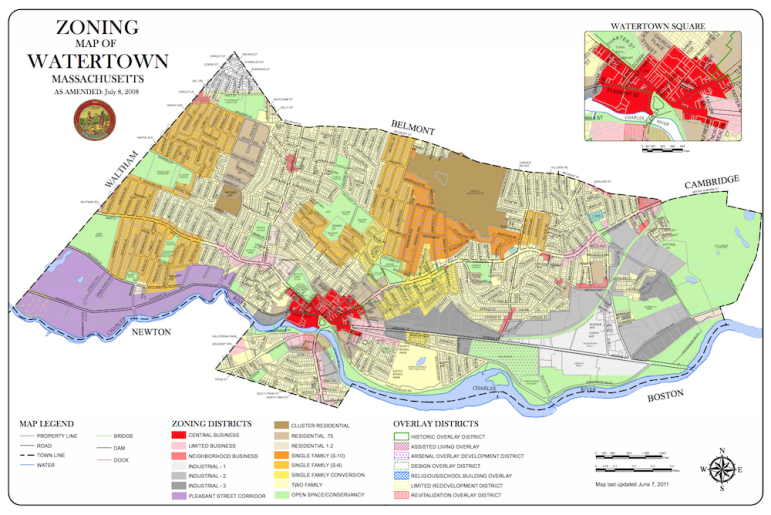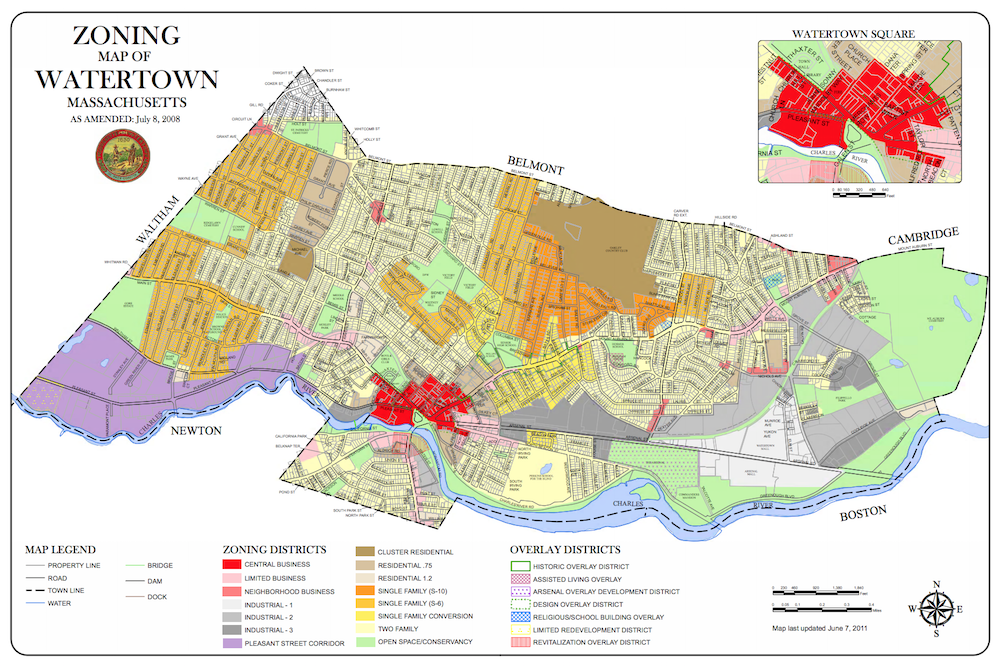
The Watertown Zoning Map shows areas with the most problems with teardowns shown in yellow/grey. They are located in the near westside of town and much of East Watertown.
A group of residents have joined with the town to try to come up with a way to prevent Watertown’s neighborhoods from being changed drastically and overbuilt, while at the same time not creating “design police.”
During last week’s “Preserving Our Neighborhoods” forum at Watertown Middle School, some in attendance wanted to look for ways to control the teardown of smaller homes and replaced with larger ones. Others did not want any new rules that limit what they can do on their property.
David Gamble, a consultant hired by the town to come up with the Residential Design Guidelines – ways to control the development in residential neighborhoods. He said there must be a balance.
“I don’t want you to think the design police are here to stop you, but we do need to have some criteria,” Gamble said. “What we need to figure out is where the line is drawn.”
He also noted that some architectures, such as Victorian and Queen Anne, were first viewed as objectionable but grew to be much loved styles.
Tia Tilson, a member of Citizens Advocacy Group, said she does not worry about renovations or small additions, but more recently she has seen the complete razing of single family homes. She objects to complete teardown of small homes and replacing them with larger buildings, often two-families, which leave less yard space sometimes remove old, healthy trees.
“We should embrace change, we are not going to stop it, but we can control it,” Tilson said.
The problem of tear downs happens most often in the areas of Watertown zoned to allow two-family homes (click here to see the zoning map).
Fayette Street resident Russ Arico said his street has had many rebuilds on it, and he likes the result.
“Compared to what was there before, what is there now it is much better,” Arico said.
He worries that proposed changes would encroach on people’s property rights. He also said he believes before any changes can be made, every property owner in town must be legally notified.
Town Councilor and developer Steve Corbett said he searched the list of homes that had been torn down and replaced with larger, multi-unit homes. He found that 31 of 40 demolition requests brought to the Historical Commission were approved right away, five were examined and not delayed, and four were delayed.
Of the tear downs, 12 were single in the two-family zone, but the result was actually three fewer units.
“I believe it is good to have developers and people willing to invest in Watertown,” Corbett said.
David Russo, chairman of the Historical Commission, said the issue is not as simple as the numbers presented. He said some homes the commission has no basis to impose a delay, so they had to allow it, and also said the number of demolition requests has increased significantly in the last year or so.
Strategies Used by Other Towns
If the town is going to do something to stop or curb the redevelopment in Watertown’s neighborhoods, there are a number of options.
Gamble has examined what other towns have down, and found that Somerville has a long local ordinance – 326 pages – specifying what can and cannot be done to homes in that city. Newton, on the other extreme, has a section describing what is OK to do, but it does not provide much detail.
One community that has something Gamble thinks might work for Watertown is Davis, Calif.
“In the description it says it seeks to reduce the hassle of individual homeowners doing small additions, while putting a check on inappropriate development,” Gamble said.
He said there could be a process where small changes have little review by the town before getting approval, while a medium sized project would have some review by the town, and large projects would have full design review by the Planning and Zoning boards.
Preservation Options
Chris Skelly from the Massachusetts Historical Commission, discussed ways homes or neighborhoods can be protected. Many towns, including Watertown, have demolition delays that can stop razing of homes for 6, 12 or even more months if they have historic or architectural significance.
Another option is a local historic district. Watertown already has one of these – the Mount Auburn Historic District. Some communities have districts as small as one property (sometimes hundreds scattered around town) while one community – Nantucket – has the entire town included in the district.
Skelly said a large majority of property owners must agree they want to be in the local historic district to make it happen.
In those areas, changes to the exterior of the building must be reviewed by a board. The commission’s authority does not extend to areas not visible from public streets and sidewalks, routine maintenance or something inside the home, Skelly said. It also does not extend to landscaping. It can be as specific as paint color, however.
He warned that just because something is on the National Register of Historic Places does not mean it has any protection. That is just an honorary designation.
A third option is architectural preservation districts. These have a commission to make recommendations about how additions and other projects are done on properties in the district.
“The commission has an advisory review, a process with a commission that could say that is not really compatible with the neighborhood but you can do it if you want,” Skelly said.
A couple communities that have architectural preservation districts are Cambridge and Ipswich.
Tools in the Town Zoning Ordinance
The town has ways to oversee and approve projects, said Town Planner Andrea Adams. Two of the most powerful tools are site plan reviews and special permits.
With a site plan review, applicants must submit detailed plans of the proposed work and go through a checklist to make sure it meets requirements such as public safety, drainage, open space and design. This is brought to the town Planning and Zoning boards, which can make recommended conditions, but cannot vote the project down, Adams said.
Special permits are required for something that is not allowed in the Zoning Ordinance but is permissible if approved by the Planing and Zoning boards. The boards can add conditions, and also have the option of outright denying the proposed project, Adams said.
Gamble said he will be writing up a draft of the Residential Design Guidelines to bring back to a public meeting early in 2016.
